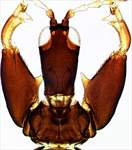
aruena head & thorax

aruena prosternites

aruena male head & thorax

catenulata head & thorax

distinctus head & thorax

newmani head & thorax

ophthalmia head & fore legs
Generic diagnosis
Large, dark macropterous Phlaeothripinae, with tuberculate fore femora. Head with eyes larger dorsally than ventrally, postocular setae slender, wide apart; maxillary stylets not deeply retracted into head, about one third of head width apart; genae sometimes with a pair of stout setae. Antennae 8-segmented, III with one sense cone, IV with 3 sense cones; VIII short and broad at base. Pronotum with anterior setae small, notopleural sutures complete. Prosternal basantra usually present, ferna large with inner margins curving forwards; meso-presternum weakly developed medially; metathoracic sterno-pleural sutures well developed. Both sexes with fore tarsal tooth well developed; fore tibia inner apical margin with tubercle or drawn-out along tarsus; fore femora with stout sub-basal tubercle, inner margin sometimes with second tubercle. Fore wing broad, no duplicated cilia but terminal cilia short. Pelta triangular with apex transverse; tergites II–VI with two pairs of wing-retaining setae; tergite IX setae S1 and S2 slender and more than half as long as tube, S3 short and stout in female but slender in male; tube shorter than head, anal setae dark. Male sternite VIII with large pore plate; tergite VIII with pair of large glandular areas surrounding insertion points of dorsoventral muscles.
Nomenclatural data
Domeothrips Crespi, Morris & Mound, 2004: 182. Type species Domeothrips aruena Crespi, Morris & Mound, 2004, by original designation.
There are 5 species described in this Australian genus.
Australian species
Domeothrips aruena Crespi, Morris & Mound, 2004: 182
Domeothrips catenulatae Crespi, Morris & Mound, 2004: 183
Domeothrips distinctus (Moulton, 1968: 104-106)
Domeothrips newmani Crespi, Morris & Mound, 2004: 184
Domeothrips ophthalmia Crespi, Morris & Mound, 2004: 185
Relationship data
Species of this genus share many character states with the species of the Australian genus Dunatothrips, but they usually have much long postocular setae, and they do not create their own domiciles.
Distribution data
Species of this genus have been found widely across the semi-arid regions of Australia.
Biological data
Found in empty domiciles created by Dunatothrips species on various species of Acacia, but it is not clear if these species are kleptoparasites or merely invaders of abandoned domiciles.
References
Crespi BJ, Morris DC & Mound LA (2004) Evolution of ecological and behavioural diversity: Australian Acacia thrips as model organisms. Australian Biological Resources Study & Australian National Insect Collection, CSIRO, Canberra, Australia, pp. 1–328.